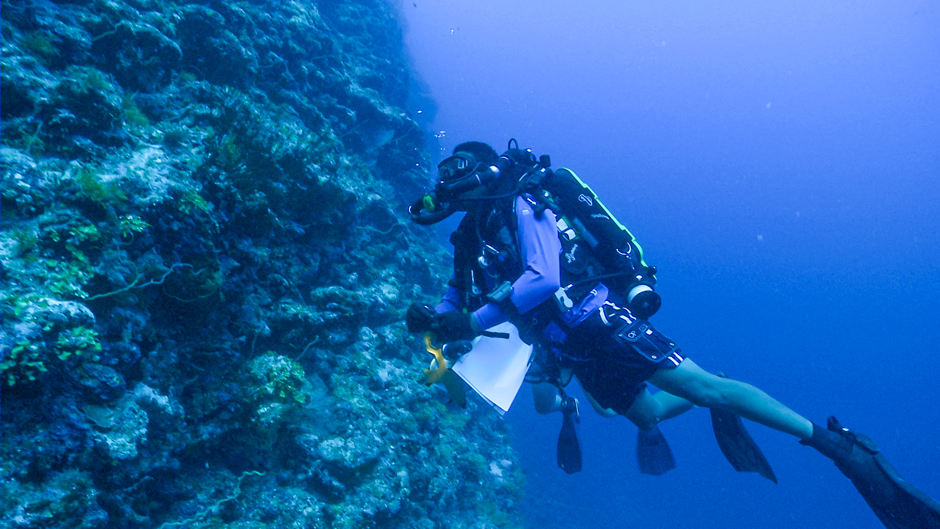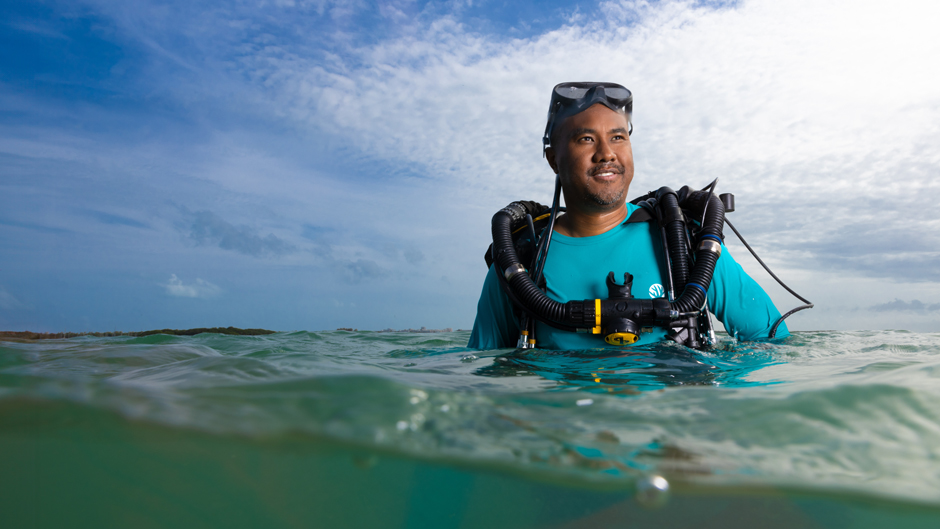Nearly 300 feet beneath the surface of the Western Pacific Ocean, his rebreather, a special apparatus that allows for extended and deeper dives, suddenly failed, cutting off the vital supply of mixed gases he needed to survive at such an extreme depth.
Never one to panic, he quickly turned on one of the aluminum “bailout bottles” of emergency air strapped to his gear—standard procedure for any deep-diving excursion—and slowly made his way back to the surface, making decompression safety stops along the way.
Danger is ever-present whenever Coleman, a marine biologist at the University of Miami Rosenstiel School of Marine, Atmospheric, and Earth Science, makes a closed-circuit rebreather dive. Rebreathers recycle exhaled air, removing it of impurities and sending it back to the diver in a breathing loop.
But equipment malfunctions can cause hypoxia. “And there’s no cue that you’re encountering it. You just pass out,” Coleman explained. “So, that’s why we carry emergency tanks, and we go down as a team, because if something goes wrong, we rely on a buddy to get back safely.”
Coleman’s underwater explorations—some can last as long as four hours—are being done in the name of important science: the quest to learn where certain species of fish have come from and, more importantly, where they are going.

“Having that information can be useful to us in many different ways,” Coleman said. “It can inform what’s happening to different species of fish from an evolutionary scale. We can look back in history, examine geological events, and use models to see what’s happened historically in terms of their movements.”
He has studied, for example, how low sea levels in the past have created land bridges between the basins of two oceans, separating a species of fish that began to develop differently in response to environmental change. “Despite looking very similar, they’re quite different,” Coleman explained, “and it’s through their genetic signal that we’re able to see just how different they are.”
During his dives to some of the deepest and darkest depths of the ocean—the so-called mesophotic zone where little light penetrates—Coleman helped discover new species of fish, some about the size of a human hand and “brilliantly colored in bright reds with contrasting purples, oranges, and yellows,” he recalled.
From the Phoenix Islands and American Samoa to Vanuatu and the Johnston Atoll, Coleman’s research expeditions to study biodiversity have carried him to some of the most remote regions of the world. But it is helping a community of Native Hawaiians on Oahu learn more about the migration patterns of certain fish in their waters that is arguably his most important work. “They fish for their livelihood, to feed their families,” Coleman said of the community with which he has worked for the past 14 years.
With marine recreational fishing licenses not required for those residents, it is difficult, if not impossible, to monitor catch rates, according to Coleman. “We have scientific studies that don’t rely on state resources, and we talk to community members and do observational work to determine that number,” he said. “But there’s still uncertainty about the long-term sustainability for certain species in their waters. So, my research group is working to determine what strategies can be implemented to protect them.”
No-fishing ordinances during spawning periods is one way to ensure certain species in Oahu are not overfished, he noted. “If we know when and where the fish are spawning, we can stop fishing in an area during that time and help ensure the survival of the next generation,” he said.
He has traveled to the island on numerous occasions to meet with those community members, using his research to help them determine which areas would benefit most from management conservation policies.
Coleman’s work with the group is an ongoing effort, one that began when he was a Ph.D. student at the Hawaii Institute of Marine Biology. And the work, he said, is as much about building relationships as it is about the science.
“For a long time, there was no science involved at all,” he recalled. “They were a bit cautious about a Western scientist coming in and worried about what any scientist might do with the information he or she gathered. So, in the beginning, a large part of working with that community was just engaging in ‘talk story,’ a Hawaiian custom of talking with old friends and passing time by chit-chatting. They wanted to learn more about me, who I was and what my motivations were for wanting to help. Slowly, we began to develop trust, and then we started to talk about the science.”
Being a person of color helped Coleman break down the barriers he encountered in his initial work with the group, he said. The son of a Black father and a Filipino mother, he grew up in a poor south Sacramento neighborhood, staying true to his convictions and avoiding the negative influences of drugs and gang violence that were prevalent in his surroundings.
“Hawaii has a very multiracial population. It’s an island where there’s a large representation of Japanese, Koreans, Portuguese, Chinese, Filipinos, and Native Hawaiians, and historically, there’s been a lot of mixture between those different groups,” Coleman said. “And in some of my earliest discussions with that community in Oahu, I learned that many of the Hawaiians I made friends with struggled with identity issues during their early childhood because their features looked less indigenous than other Hawaiians. And so, we were able to relate to each other’s struggles—me being mixed, growing up in America, and having identity issues growing up in terms of identifying as Black or as Filipino.”
He would meet with community residents in their homes, often going fishing with them and listening intently to the “aunties” and “uncles,” the neighborhood elders with local knowledge of fish movements that even scientists lacked. “They knew there was something happening with shifts in the locations of some fish, and they knew the times of year those shifts occurred,” Coleman said. “And often, those movements coincided with seasonal changes.”
Warming ocean temperatures, he believes, may be affecting the movements of certain species in those waters, particularly of goatfish, a popular food fish for the community with which he is collaborating.
“We’ve always had these extreme heat waves, but the frequency in which they’re happening is just becoming more and more common,” Coleman said. “In corals, the effect of these heat waves is obvious—the corals turn white. So, there’s been a lot of research looking at corals, but nobody’s really looking at the fish and how these extreme heat waves are affecting them.”
He has been collecting tissue samples from juvenile goatfish in the waters of Oahu over a 10-year period, studying the genetic signals in those samples to determine whether extreme heat waves have disrupted populations of the species.
Coleman plans to share his research efforts with community members. “I’m not living in Hawaii anymore,” he said, “but the relationships I’ve built with that community are still flourishing.”

